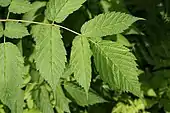Aruncus dioicus
Aruncus dioicus, known as goat's beard, buck's-beard[1] or bride's feathers, is a flowering herbaceous perennial plant in the family Rosaceae, and is the type species of the genus Aruncus. It has alternate, pinnately compound leaves, on thin, stiff stems, with plumes of feathery white or cream flowers borne in summer. This plant can be found in moist woodland, often at higher altitudes, throughout temperate areas of Europe, Asia, and eastern and western North America. In the UK it is considered suitable for planting in and around water areas,[2] and has gained the Royal Horticultural Society's Award of Garden Merit.[3][4]
| Aruncus dioicus | |
|---|---|
 | |
| Inflorescence | |
| Scientific classification | |
| Kingdom: | Plantae |
| Clade: | Tracheophytes |
| Clade: | Angiosperms |
| Clade: | Eudicots |
| Clade: | Rosids |
| Order: | Rosales |
| Family: | Rosaceae |
| Genus: | Aruncus |
| Species: | A. dioicus |
| Binomial name | |
| Aruncus dioicus (Walter) Fernald | |
The Latin specific epithet dioicus means "having the male reproductive organs on one plant, and the female on another".[5]

In Italy the young shoots are eaten, usually boiled briefly in herb infused water, and then cooked with eggs and cheese. In Friuli it is one of the ingredients in the local home-made soup based on wild greens called 'pistic'.[6]
Aruncus dioicus var. kamtschaticus has shown potent cytotoxicity against Jurkat T cells.[7]
Varieties
- Aruncus dioicus var. aethusifolius (H.Lév.) H.Hara – Korean goatsbeard[8]
Uses
Native Americans in the Northwest used the plant medicinally as a diuretic, as a poultice, and to treat blood diseases, smallpox, and sore throats.[9]
References
- "BSBI List 2007". Botanical Society of Britain and Ireland. Archived from the original (xls) on 2015-01-25. Retrieved 2014-10-17.
- BS 7370-5 Recommendations for maintenance of water areas
- "RHS Plant Selector - Aruncus dioicus". Retrieved 23 February 2020.
- "AGM Plants - Ornamental" (PDF). Royal Horticultural Society. July 2017. p. 8. Retrieved 6 February 2018.
- Harrison, Lorraine (2012). RHS Latin for Gardeners. United Kingdom: Mitchell Beazley. ISBN 978-1845337315.
- Ghirardini, M.; Carli, M.; Del Vecchio, N.; Rovati, A.; Cova, O.; Valigi, F.; Agnetti, G.; MacConi, M.; Adamo, D.; Traina, M.; Laudini, F.; Marcheselli, I.; Caruso, N.; Gedda, T.; Donati, F.; Marzadro, A.; Russi, P.; Spaggiari, C.; Bianco, M.; Binda, R.; Barattieri, E.; Tognacci, A.; Girardo, M.; Vaschetti, L.; Caprino, P.; Sesti, E.; Andreozzi, G.; Coletto, E.; Belzer, G.; Pieroni, A. (2007). "The importance of a taste. A comparative study on wild food plant consumption in twenty-one local communities in Italy". Journal of Ethnobiology and Ethnomedicine. 3: 22. doi:10.1186/1746-4269-3-22. PMC 1877798. PMID 17480214.
- Jeong, S. Y.; Jun, D. Y.; Kim, Y. H.; Min, B. S.; Min, B. K.; Woo, M. H. (2011). "Monoterpenoids from the aerial parts of Aruncus dioicus var. Kamtschaticus and their antioxidant and cytotoxic activities". Bioorganic & Medicinal Chemistry Letters. 21 (11): 3252–3256. doi:10.1016/j.bmcl.2011.04.043. PMID 21546250.
- English Names for Korean Native Plants (PDF). Pocheon: Korea National Arboretum. 2015. p. 362. ISBN 978-89-97450-98-5. Archived from the original (PDF) on 25 May 2017. Retrieved 24 December 2016 – via Korea Forest Service.
- Fagan, Damian (2019). Wildflowers of Oregon: A Field Guide to Over 400 Wildflowers, Trees, and Shrubs of the Coast, Cascades, and High Desert. Guilford, CT: FalconGuides. p. 81. ISBN 1-4930-3633-5. OCLC 1073035766.